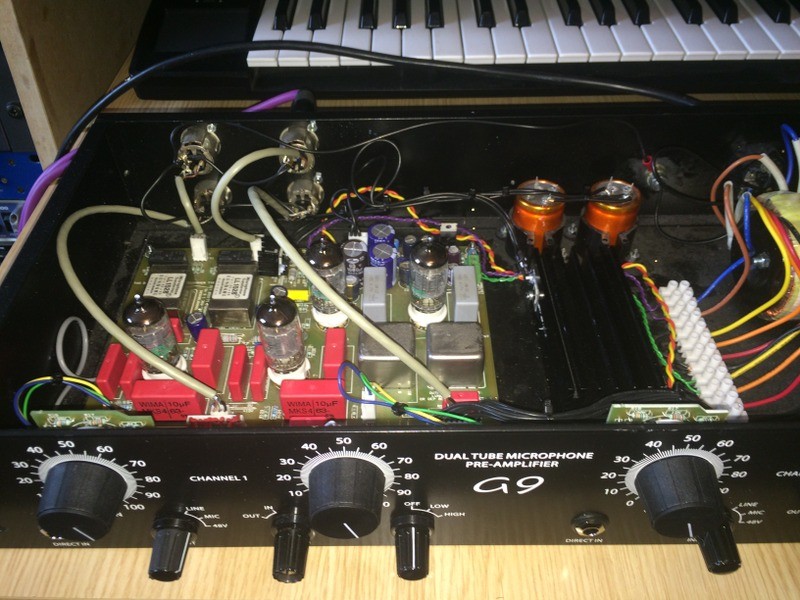Re 60 or 50HZ hum (or 100 or 120 hz)....
Forgive me if this is redundant.
Suggestions:
Between the transformer and the barrier strip, and the transformer and the mains: Twist each pair associated with the transformer (not all together, just the pair for each coil). They will radiate less because the radiation will cancel more.
The big Caps are reservoir caps for smoothing, so the power from should avoid being run through AC fields. One approach is to route them around the AC lines. Another approach is to twist them (as you have done with the AC lines). Twisting them will reduce the amount of noise they pick up because they will both pick up the same amount of noise and it "can" cancel. Doing both is best. You could also move the caps closer to the PSU. (from the picture it looks like the leads going to the caps are separated and actually touching the ac PSU input lines).
Other stuff I could not see... 1) How is your DI wiring routed. This is a very sensitive part of the circuit, maybe don't run it too near the case.
General rules of thumb:
Be careful about routing wires near inputs because inputs are amplified (and so is any noise). This is ESPECIALLY true of the di input.
Twist anything that radiates
Twist anything that can pick up noise
Cross radiators and things that pick up noise at a 90 degree angle.
Keep radiators and things that pick up noise as far apart as you can (distance is nature's mu-metal).
(A gilding the lilly suggestion... The mains transformer tends to pollute the case with noise, so you can sometimes reduce noise by lifting the PCB a bit higher (3/8 inch standoffs instead of 1/4) if the tops of the tubes clear. But this can only matter (and not very much) if you are managing radiation in the box well to start with. It is primarily effective in getting the DI and the input transformers a little further from the case. Lifting the transformer would probably work too.)
Figure out what the frequency of noises is, and use that to guide you. Low frequency constant noise is generally called hum and related to mains power frequency and multiples thereof (in the USA 60 120 240hz, etc)
High frequency noise is generally called hiss and is not related to power but usually related to high impedance inputs (like the DI input) picking stuff up (stuff includes switching power supply noise , fluorescent lamps, dimmers, radio).
When testing your preamp terminate the input with something that looks like a mic (150 ohm resistor for instance). Unterminated it is not a good test. Furthermore any noise test should be done with the lid on (because the metal box shields noise from fluorescent lamps and switching PSU's etc.).
djfatum a few posts before this one put some pictures up. djfatum's wire routing appears excellent. Look how far he was able to separate the AC and DC power. Look at the AC mains routing, it is very nicely done. note how the input leads lean away from the PSU. Note how the AC leads are short as practical, they run over the board (but not over the transformers) to be shorter. The only improvements I could see might be to move the board further from the transformer and move the PSU caps closer to the board, but there may be reasons that he/she couldn't do that. djfatm did a really nice job. Here is a link to the picture:
,




































